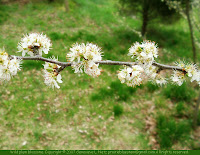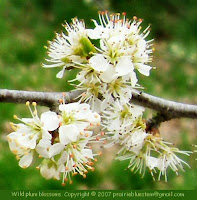Beautiful wild shrubs
The wild plums have been blooming this week on the "south bank" of our small rural property. I love to walk through that part of the yard. The fragrance of the blooms fills the air all around the little plum thicket.
On that south bank, the plums always bloom a little too early and are nearly always frosted. There are never enough plums to make jelly. But to me, they're worth having just for these days of spring when they are blooming.

Related posts:
Wild Fruits of the Nebraska Sandhills
Springtime in Christian County, Kentucky


4 comments:
How large are these plants? I've thought of planting a wild plum in my backyard for its wildlife value. The only time I've seen them growing in the wild is out on Fire Island, a barrier island, where they grow dense and stunted by wind and salt spray.
Xris, if you look back at the photo I took of the wild plums last year you can get an idea of the size and form of these particular plums. They are a mixture of Kansas and Kentucky plums which I started from seed.
They're rather spindly little bushes and they send up a lot of suckers so they can form a thicket. The tallest ones might be about six feet tall.
There may be other species that "bush out" more than these.
If you're looking for a shrub with a lot of wildlife value, this is probably not it. American Wildlife and Plants by Alexander C. Martin, Herbert S. Zim, and Arnold L. Nelson (1951: New York, McGraw Hill) says the following:
Wild plums belong with the wild cherries botanically, but their differences in growth, fruit and wildlife use set them apart. About 16 species of plums are present in various parts of the country, but their fruits are not used so much by wildlife as might be anticipated. Foxes are the chief consumers. Plum thickets often furnish valuable protective shelter.
Then it lists the following consumers of the fruit:
Blackheaded Grosbeak in California
Ringtailed Cat in Texas
Gray Fox in the Southeast and Northeast
Hope this helps.
These are so beautiful. I continue to be in awe of your love and appreciation of nature.
Hi, Stephanie. Thanks for your kind comment. There are some things in nature that I have taught myself to look at carefully and to study a little. But there is a vast body of human knowledge about the plant and animal kingdoms that I have never even peeked at. So I guess I still have a lot left to appreciate. That's good -- it keeps life interesting!
Post a Comment